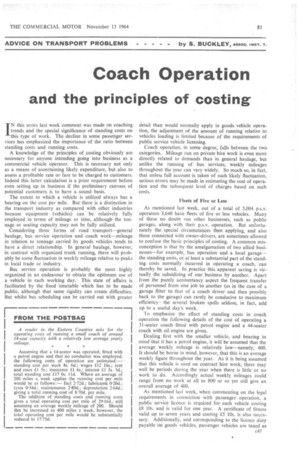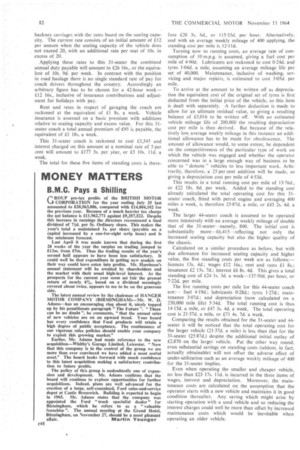Coach Operation
Page 83

Page 84

If you've noticed an error in this article please click here to report it so we can fix it.
and the principles of costing
IN this series last week comment was made on coaching trends and the special significance of standing costs on this type of work. The decline in some passenger services has emphasized the importance of the ratio between standing costs and running costs.
A knowledge of the principles of costing obviously are necessary for anyone intending going into business as a commercial vehicle operator. This is necessary not only as a means of ascertaining likely expenditure, but also to assess a profitable rate or fare to be charged to customers. Indeed this latter calculation is a prior requirement before even setting up in business if the preliminary canvass of potential customers is to have a sound basis.
The extent to which a vehicle is utilized always has a bearing on the cost per mile. But there is a distinction in the transport industry as compared with other industries because equipment (vehicles) can be relatively fully employed in terms of mileage or time, although the tonnage or seating capacity may not be fully utilized.
Considering three forms of road transport—general haulage, bus service operation and coach work—mileage in relation to tonnage carried by goods vehicles tends to have a direct relationship. In general haulage, however, in contrast with organized trunk running, there will probably be some fluctuation in weekly mileage relative to peaks in local trade or industry.
Bus service operation is probably the most highly organized in an endeavour to obtain the optimum use of a vehicle in each working day. This state of affairs is facilitated by the fixed timetable which has to be made public, although that same rigidity can create difficulties. But whilst bus scheduling can be carried out with greater detail than would normally apply in goods vehicle operation, the adjustment of the amount of running relative to vehicles loading is limited because of the requirements of public service vehicle licensing.
Coach operation, in some degree, falls between the two categories. Mileage run on private hire work' is even more directly related to demands than in general haulage, but unlike the running of bus services, weekly mileages throughout the year can vary widely. So much so, in fact, that unless full account is taken of such likely fluctuation, serious errors may be made in estimating the cost of operation and the subsequent level of charges based on such costs.
Fleets of Five or Less
As mentioned last week, out of a total of 5,004 p.s.v. operators 3,640 have fleets of five or less vehicles. Many of these no doubt run other businesses, such as public garages, along with their p.s.v. operation. But unfortunately the special circumstances then applying, and also those connected with owner-drivers, are sometimes allowed to confuse the basic principles of costing. A common misconception is that by the amalgamation of two allied businesses—for example, bus operation and a local garage— the standing costs, or at least a substantial part of the standing costs normally incurred in operating a coach, can thereby be saved. In practice this apparent saving is virtually the subsidizing of one business by another. Apart from the purely accountancy aspect the frequent transfer of personnel from one job to another (as in the case of a garage fitter to that of a coach driver and then possibly back to the garage) can rarely be conducive to maximum efficiency—the several broken spells seldom, in fact, add up to a useful day's work.
To emphasize the effect of standing costs in coach operation the following details of the cost of operating a 31-seater coach fitted with petrol engine and a 44-seater coach with oil engine are given.
Dealing first with the smaller vehicle, and bearing in mind that it has a petrol engine, it will be assumed that the average weekly mileage is relatively low—namely, 400. It should be borne in mind, however, that this is an average weekly figure throughout the year. As it is being assumed that this vehicle is used on contract hire work, there may well be periods during the year when there is little or no work to do. Accordingly actual weekly mileages could range from no work at all to 800 or so yet still give an overall average of 400.
As mentioned last week, when commenting on the legal requirements in connection with passenger operation, a public service licence is required for each vehicle costing ES 10s. and is valid for one year. A certificate of fitness valid up to seven years and costing £5 10s. is also necessary. Additionally, and corresponding to the licence duty payable on goods vehicles, passenger vehicles are taxed as hackney carriages with the rates based on the seating capacity. The current rate consists of an initial amount of £12 per annum when the seating capacity of the vehicle does not exceed 20, with an additional rate per seat of 10s. in excess of 20.
Applying these rates to this 31-seater the combined annual duty payable will amount to £26 16s., or the equivalent of 10s. 9d. per week. In contrast with the position in road haulage there is no single standard rate of pay for coach drivers throughout the country. Accordingly an arbitrary figure has to be chosen for a 42-hour week £12 16s., inclusive of insurance contributions and adjustment for holidays with pay.
Rent and rates in respect of garaging the coach are reckoned at the equivalent of LI 8s. a week. Vehicle insurance is assessed on a basic premium with additions relative to seating capacity and excess value. For this 31seater coach a total annual premium of L95 is payable, the equivalent of £1 18s. a week.
This 31-seater coach is reckoned to cost £3,545 and interest charged on this amount at a nominal rate of 5 per cent will amount to £177 5s. per year, or £3 10s. lid, a week.
The total for these five items of standing costs is there fore £20 3s. 8d., or 115-33d. per hour. Alternatively, and with an average weekly mileage of 400 applying, the standing cost per mile is 12-11d.
Turning now to running costs, an average rate of consumption of 10 m.p.g. is assumed, giving a fuel cost per mile of 4-90d. Lubricants are reckoned to cost 0-24d. and tyres 1-04d. a mile, assuming an average mileage life per set of 40,000. Maintenance, inclusive of washing, servicing and major repairs, is estimated to cost 3-05d. per mile.
To arrive at the amount to be written off as depreciation the equivalent cost of the original set of tyres is first deducted from the initial price of the vehicle, so this item is dealt with separately. A further deduction is made to allow for an ultimate residual value, so giving a resulting balance of £3,016 to be written off. With an estimated vehicle mileage life of 200,000 the resulting depreciation cost per mile is then derived. But because of the relatively low. average weekly mileage in this instance an additional allowance has to be made for obsolescence. The amount of allowance would, to some extent, be dependent on the competitiveness of the particular type of work on which the vehicle was engaged and whether the operator concerned was in a large enough way of business to be able to "demote " vehicles to less important work. Arbitrarily, therefore, a 25 per cent addition will be made, so giving a depreciation cost per mile of 4-53d.
This results in a total running cost per mile of 13-76d., or £22 18s. 8d. per week. Added to the standing cost already calculated the total operating cost for this 31seater coach, fitted with petrol engine and averaging 400 miles a week, is therefore 25-87d. a mile, or £43 2s. 4d. a week.
The larger 44-seater coach is assumed to be operated more intensively with an average weekly mileage of double that of the 31-seater-namely, 800. The initial cost is substantially more-f6,415--reflecting not only the increased seating capacity but also the higher quality of the chassis.
Calculated on a similar procedure as before, but with due allowance for increased seating capacity and higher value, the five standing costs per week are as follows: licences 13s. 4d.; wages £12 16s.; rent and rates 8s.; insurance £2 15s. 7d.; interest £6 8s. 4d. This gives a total standing cost of £24 Is. 3d. a week-I37-50d. per hour, or 7.22d. per mile.
The five running costs per mile for this 44-seater coach are:fuel 4-19d.; lubricants 0-28d.; lyres 1.27d.; maintenance 3-07d.; and depreciation (now calculated on a 250,000 mile life) 5-34d. The total running cost is thus 14-15d. a mile, or £47 3s. 4d. a week. The total operating cost is 21-37d. a mile, or £71 4s. 7d. a week.
Comparing the results obtained for the 31-seater and 44seater it will be noticed that the total operating cost for the larger vehicle (21-37d. a mile) is less than that for the 31-seater (25-87d.) despite the additional initial outlay of £2,870 on the larger vehicle. Put the other way round, even substantial savings on standing costs (seldom, in fact, actually obtainable) will not offset the adverse effect of under-utilization such as an average weekly mileage of 400 for the 31-seater implies.
Even when operating the smaller and cheaper vehicle, no less than £23 17s. lid. is incurred in the three items of wages, interest and depreciation. Moreover, the maintenance costs are calculated on the assumption that the operator starts with a new vehicle and maintains it in good condition thereafter. Any saving which might arise by starting operation with a used vehicle and so reducing the interest charges could well be more than offset by increased maintenance costs which would be inevitable when operating an older vehicle.
























































































































